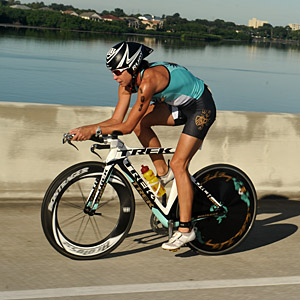Julie Dibens Q&A – Part 1
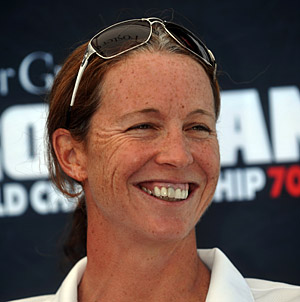
For some people, earning a starting spot in the Olympics is the dream culmination of a sporting career. But for the Salisbury, Great Britain native who swam for the Louisiana State University Tigers with Becky Lavelle, it turns out her two Olympic qualifications were more like a disappointing mirage before her real triathlon greatness dawned in rugged terrain and at the longer distances.
After her swim career peaked with a 5th place finish in the 200-meter backstroke at Great Britain’s 1996 Olympic Trials, Dibens – then Julie Ricketts — took up triathlon in 1997 and by 1999 she had developed a strong bike and a good enough run to contest ITU World Cups and aim at one of Great Britain’s three Olympic slots for the 2000 games in Sydney. Sadly, a month before the Games, Ricketts tore her ACL and had to watch as reserve Michelle Dillon took her spot. After nearly two years of rehab, she recovered in time to grab a second Olympic slot with an 8th place finish at the 2004 ITU World Championship in Madeira Portugal. But once again, bad luck struck and Ricketts broke a toe while running from the beach to the bikes at an ITU World Cup in Manchester a month before the Athens Games. Adopting a warrior ethic, she sucked up the pain and made the start but lack of training left her 30th and a bit fed up with Olympic politics.
Julie was also left with a series of operations to cure her foot woes that wiped out all of 2005. By the time she got rolling again in 2006, her then coach Richard Hobson prescribed a hiatus from the pressurized world of ITU short course racing and a diet of fun races in enjoyable places. And instead of beating her head against the wall trying to develop a faster run, he told her to focus on further developing her already potent bike into the nuclear weapon it is today. And just to keep things loose, he urged her to hop on a mountain bike and enter the rugged and fun-filled world of XTERRA.
During this evolutionary period, Julie struck fear into her Olympic distance competitors by building leads on the bike at the big-money, non-drafting races like Life Time Fitness in Minneapolis, Chicago, and LA and hanging on for decent prize money finishes. But she really nailed XTERRA, taking World titles in 2007, 2008 and 2009. At the same time, she branched out to the half Ironman distance and 70.3 races where her bike skills had more ground to build leads. By 2007, she won the St. Croix and UK 70.3 races and built a huge lead at the Ironman 70.3 World Championship in Clearwater before fading to 4th on the run.
In 2008, she won Austria and Switzerland 70.3s but faded again at Clearwater – which turned her quest into an obsession for 2009.
In 2009, she overcame three cracked ribs in a crash at Xterra Saipan, and a crash on the bike at Chicago that left her with a banged up elbow and fingers. In the season around that, she finished second in the Life Time Fitness-Toyota Cup Olympic distance points series, outdueled good friend and training partner Chrissie Wellington at the Boulder 5430 long course half Ironman, and took dead aim at an XTERRA three-peat and finally solving the mystery of Clearwater.
On the strength of both those World Titles, Dibens joined the ranks of the sport’s elite – and earned a slot for her Ironman baptism at Kona in 2010. In the last days of training at her new home in Boulder before an expedition to Abu Dhabi for a date with Ironman stars battling for the $50,000 top prize at a 3km/200km/20km test in the Arabian Gulf, Dibens offered a few thoughts on her life and 2010 campaign.
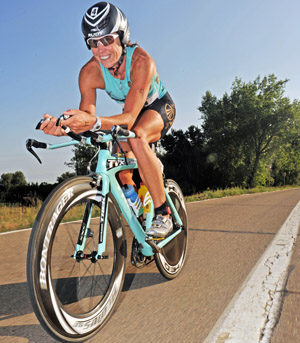
Slowtwitch: Why race Abu Dhabi?
Julie Dibens: After I won Clearwater I got my slot for Kona. So it seemed like a perfect opportunity for me to see how I did at the longer distance.
ST: What makes this a good preparation for Kona?
JULIE: It’s gonna be a hot race. The bike is longer than Kona. The run is only a 20k. But with the bike being 200k, I’ll get a good feeling for A, whether I enjoy long distance races. And B, how I do compared to some of the Ironman girls I have never raced before.
ST: What does the bike over distance (200k) and under distance (20k) of the run help?
JULIE: I think this is good for this time of year because having a shorter run will take less time to recover. I can still come back, recover and continue to race a full season as I have done in the past. Having a longer bike we will see different triathletes than normal triathlons do. So I think it will give a chance for some other people to shine.
ST: Many of whom can break three hours on the marathon and go like hell on the bike. Yvonne Van Vlerken, Samantha McGlone, Rebekah Keat, Catriona Morrison, Leanda Cave, Tereza Macel will be there. Almost a Kona-quality field.
JULIE: I think is a funny time of the year. Not many are in the best shape of the year in March. So, I am going into it like I am on the sideline wanting to win. I feel like I am in good shape. But I think there is a lot more to come. You can't sustain your form from now throughout the season all the way to October-November. So I’ve kind of kept that in the back of my mind. So we will see.
ST: Why did you want to do Ironman?
JULIE: I still haven’t definitely decided. CHUCKLES If I go to Abu Dhabi and I do not enjoy racing long distance, then…
ST: How could you not?
JULIE: I’ll be surprised if I am not racing in Kona this year. But as I said earlier. A lot of it is how I enjoy it. So if for some reason I went to Abu Dhabi and didn’t enjoy the race. I have changed my training over the winter just for Abu Dhabi… I’m in good shape. Probably the best shape I've ever been fore this time of year. Ahem I always said if I don’t enjoy the training for Ironman, I’m not going to do it. But y’know, the proof will be on race day.
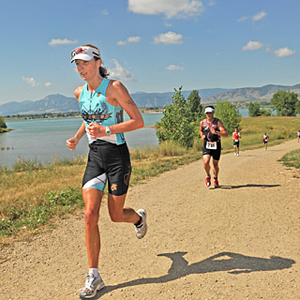
ST: How much greater volume will you do if all systems are go for Kona?
JULIE: I don’t think I will ever do crazy miles. I will keep a fair amount of intensity in there. I want to be able to still race well in some 70.3s and even some Olympic distance races. I am not willing to give up on that. I’ll definitely have to up the volume. I have already on the biking and I will gradually do that on the running. With my track record for injuries I will really have to be careful. I have never really been up to run silly mileage.
ST: Paula Newby-Fraser said the best advice she got on Ironman training was to do the least amount of mileage that she can get away with. Also, according to Brett Sutton, he kept Chrissie to much less mileage than many of his other women Ironman stars.
JULIE: I've seen pretty much how Chrissie trains. She doesn’t do silly mileage. Yes she trains hard and she trains long. But it’s not she doesn’t go out on three hour runs and things like that, as I know some people have to do.
ST: Do you have fear you could just fold on the run?
JULIE: There is always that fear. I have folded too many times. That fear is always going to be there. As I said in Clearwater, I have about three days a year when my best run is there. CHUCKLES So I have to save all those three for Kona this year.
ST: In your own mind, will you have the aerobic strength to last the whole 26 miles at a good pace? Do you imagine you can compete to the last mile at Kona?
JULIE: I definitely have some numbers in the back of my head in training that I can go into that race with confidence. But you just never know. Especially with the whole nutrition side of things. It will be unnerving knowing so many people have come to Kona and had shocking first races there.
New challenges tackling the Ironman Distance
ST: Questions marks you have had about nutrition? How much sweat rate. Percentage of salt loss?
JULIE: I definitely have a lot of questions. Everyone says that nutrition is the fourth discipline of Ironman. For the most part in Olympic, Xterra and Olympic distance, I have gotten away with not really having a nutrition plan for the race and getting away with it for the most part. It is an aspect to look into and we are going to be trying some new stuff going into Abu Dhabi, trying to make sure I take in more calories than I have in the past. And taking in more electrolytes than I do because I have a pretty high sweat rate.
ST: Not a Scott Molina sweat rate, which is 2 and a half liters an hour.
JULIE: Yeah I don’t know the exact numbers but it is pretty high. So dehydration especially in Kona will be a big factor. That is something I am going to work on between now and then.
ST: Who is advising you on nutrition?
JULIE: I am working with Power Bar this year. They are quite interested to help me out as much as possible. I’ve been chatting with Chris Lieto at the Trek-K Swiss camp. I think he’s got a lot of knowledge and he is willing to share it with me. I also got in touch with Brian Shea of Personal Best Nutrition, who has a wealth of knowledge. He has given me some guidelines and steps and I am working with him to come up with a plan for Abu Dhabi.
Lessons learned at Clearwater 2007 bonk
ST: If I remember correctly you had a pretty tough bonk at the 2007 Clearwater race. Tell me how that went down and what contributed to that?
JULIE: I think I led the swim and came out 30 seconds ahead and then had a good 4-5 minutes lead coming off the bike – plus I had seven minutes on Rinny (Mirinda Carfrae). I ran way too fast the first couple of miles. I just came off winning my first Xterra title. I was super fired up and happy and confident and got caught up in the moment. And ran way too hard the first couple of miles.
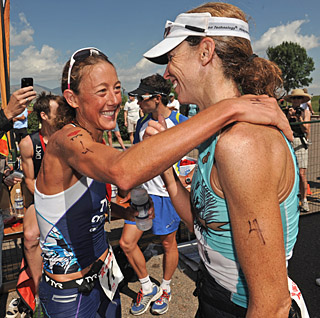
ST: Were you running simply too fast or what?
JULIE: Too fast. My first mile was just under 5:30. (1:12 half marathon pace. Best women’s time ever is 1:17.) Which is way too fast for me.
ST: Six minute miles would give you a 1:19.
JULIE: Like 1:18. So it was ridiculous.
ST: Why didn’t you realize that?
JULIE: It is hard to really appreciate it unless you race. When the crowds are all cheering for you and you’re feeling good, you can really just get caught up in the moment. And then all of a sudden you get to the first mile mark and you look at the split… CHUCKLES ‘Look here!‘
ST: Once you started to unravel, how did you survive? What could you do to minimize the damage?
JULIE: I slowed it down consciously. I was still running OK for the first 10K but I was already getting muscle cramps. I think from, biking hard and not having been on my time trial bike for two weeks. That’s because I’d raced Maui just weeks before and I had grown unaccustomed to the time trial position, I even remember getting off the bike and thinking: ‘My quads are really, really tight. They feel like they are going to cramp.’ Somehow I thought that by running a really fast first mile they’d disappear. LAUGHS, They didn’t. CHUCKLES. So I ran the first lap OK but I was hurting. And it was only at Mile 9, after you got over the causeway bridge that the wheels really started to come off. Then the last 2-3 miles it was a case of just getting to the finish line. I was walking through the aid stations.
ST: Your legs felt like stovepipes? You don’t get applauded for finishing a death march. But that actually required a lot of character.
JULIE: I don’t think I would change anything from that race. I really went after it. I wanted to win it that year and I was a little naive a bit in my tactics. But I love to race hard from the gun and to lay it all out there. I’d much rather do that.
ST: How many half Ironman races had you done by then?
JULIE: Not many. Maybe three.
The Olympic distance years
ST: How exhilarating was it to make two Olympic teams?
JULIE: They were both fantastic experiences Growing up as a swimmer I’d always dreamt of going to the Olympics. (I am from Salisbury Great Britain). I went to LSU and swam in NCAA competition [with Becky Lavelle]. Then, towards the end of my swimming career I knew that was never going to happen.
ST: How close did you come?
JULIE: I was 5th in Great Britain’s Olympic Trials in the 200 meter backstroke.
ST: You needed to finish second. How far off were you?
JULIE: I was probably a couple seconds off. Then I got into triathlon in ’98 and heard it was an Olympics sport and in ‘99 started to try to qualify. In the third selection race, I had a breakthrough and came in third at the European Championships at Stein in Holland which gave me the slot.
ST: Who were the other two women on the British Olympic triathlon team?
JULIE: It was Sian Brice and Stef Forrester. Michelle Dillon was the reserve. Then I got injured a couple weeks before the actual event in Sydney and had to withdraw. It was pretty heartbreaking at the time. I had a partially torn ACL in my left knee. They think I got it in a bike crash earlier in the year. Just never picked up on it and it just gradually got worse.
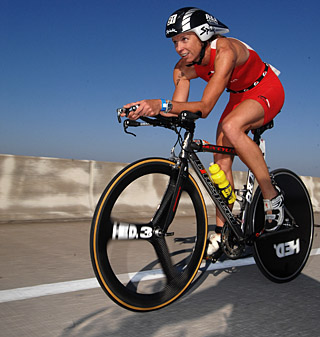
ST: What action unraveled it?
JULIE: Running one day, I couldn’t even run two steps. So it was pointless for me to prevent Michelle from racing.
ST: What did you feel when you saw the women’s final and the drama and exhilaration?
JULIE: I guess I had mixed emotions. Obviously I really wanted to race. And as a team, we didn’t have much luck on the day because Sian crashed, Stef couldn’t get her wetsuit off and Michelle’s stem broke. Michelle eventually finished the race. But we didn’t have anything like what we had hoped. But just being there and experiencing it was fantastic. It really helped me be prepared when I qualified for the 2004 Olympics in Athens.
ST: In 2004, the Olympic field was tougher and deeper . The course was tougher.
JULIE: That is also when Great Britain really started to pick up. Michelle started racing well. Annaliese Heard and Helen Tucker were starting to come on the scene. Leanda [Cave.] and Andrea Whitcombe, too. I’m sure I am missing others. But it was really hard to just qualify for the team. Again, after Sydney I had two knee surgeries to try to get that right.
ST: How long did it take to recover from the surgeries?
JULIE: They just took a while. I don’t think I raced the whole of 2001. I started to race again in 2002.
ST: Leanda Cave won Worlds in 2002. Did that inspire you?
JULIE: Yeah that was pretty awesome. And then in 2004 I started to get fit again and managed to qualify for Athens at the World Championships in Madeira. We had to come top 8 to get automatic selection. I got 8th and surprised some people.
ST: What were your weakest and strongest legs at the time?
JULIE: I came from a swim background, so that was always easy. The first couple years I really backed off on the swimming. But then realized I couldn’t afford to do that. So, I have to keep a fair amount of swimming in there to come out front pack. Biking came pretty naturally. I think now that is my strength in triathlon.
ST: Type of course makes a difference. Some have corners and hills. How fit were you for Athens and its steep hills?
JULIE: I always used to do pretty well on the technical courses with a lot of turns.
ST: That would include Hamburg?
JULIE: Yep. And did well on some of the hilly courses. I think Athens was a bit too steep. I am one of the tallest girls and some of the tiny little light girls could fly up that hill. .
ST: And some fell over. Tiny ones too. Just too steep.
JULIE: I definitely like a hard course.
ST: How did you do on the Olympic race?
Julie: On the big day, I came 30th. Again, I had a bit of an injury leading up to it. There were lot of politics going on with British triathlon and selection. Who they selected, why they selected. So it didn’t leave a good taste in my mouth about the Olympics. To be honest after the race was over, I wanted nothing to do with the Olympics again after all the infighting that was going on. I still enjoyed it and wouldn’t change it for the world. But I just wish there were other circumstances surrounding it. I think people have this image of qualifying and going to the Olympics as a fantastic experience and it’s all like Happy Days. But there are a lot of people there. Because we push ourselves so far. It is the biggest race of your career – biggest race in the world — every four years. Lot of people go in there with slight injuries and stuff. It’s not what you dream it to be. There is a lot of pressure put on by your national federations. . They are trying to secure funding for the next four years and if you don’t produce a medal, then it's hard for them.
ST: What was your injury?
JULIE: I stepped on a rock in the swim-to-bike transition at a World Cup at Manchester the month before the Olympics and I think it just loosened up the ankle joint. Because it was so close to the Games and because of what happened in Sydney, I was so bloody minded I was going to get to the start line no matter what. I ended up dislocating the toe. Because of that I had three surgeries after Athens just to try and get it right. So I was out all of 2005 and part of 2006 trying to get that sorted.


